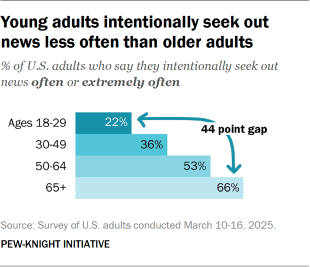
Young Adults and the Future of News
Illustrations by Christa Jarrold
The ways Americans get news and information have transformed dramatically in the 21st century. The news habits of the youngest adults reflect this shift – and may offer some insight into what the future holds.

Young adults now follow the news less closely than every other age group. Overall attention to news has declined since 2016, and the youngest age group has remained consistently at the bottom.

At the same time, there is one place where young adults are more likely to get news than every other age group: social media.

Adults under 30 also are more likely than any other age group to trust the news they see on social media sites. In fact, young adults trust news from social media as much as they trust news from national news organizations.
To better understand the U.S. media landscape, Pew Research Center has surveyed Americans over time about their news habits and attitudes. Time and time again, the youngest adults stand out from the crowd in their unique ways of consuming news and their views of the news media.
This essay examines how the youngest group of adults – those ages 18 to 29 – consume news, interact with it, and perceive its role in their daily lives. In doing so, it paints a picture of a generation of Americans that is both shaping, and being shaped by, the evolving news environment. As we look toward the future, understanding young adults’ news habits may be key to anticipating the direction the news landscape is headed.
Young adults are less likely to follow the news
Attention to news in the U.S. – measured by the share of adults who say they follow news all or most of the time – has declined across all age groups since 2016. Young adults (ages 18 to 29) have consistently had the lowest levels.
| Type of news | Ages 18-29 | 30-49 | 50-64 | 65+ |
|---|---|---|---|---|
| National | 54% | 61% | 77% | 85% |
| Local | 48 | 55 | 71 | 78 |
As of 2025, 15% of young adults say they follow the news all or most of the time. Comparatively, 62% of the oldest Americans say they do this – about four times as many.
This holds true for different types of news. Young adults are less likely than all older age groups to say they closely follow national and local news. Young adults also differ in the news topics they follow. They are less likely than older adults to say they often or extremely often get news about government and politics, science and technology, and business and finance.[LINK TO APPENDIX] They are only slightly less likely to often get sports news – and more likely to get entertainment news. About a third (32%) of young adults say they get entertainment news extremely often or often, compared with 13% of the oldest adults (those 65 or older).
| Age group | Because they are looking for it | Because they happen to come across it |
|---|---|---|
| Ages 18-29 | 30% | 70% |
| 30-49 | 39 | 60 |
| 50-64 | 50 | 49 |
| 65+ | 61 | 38 |
| Feeling | Ages 18-29 | 30-49 | 50-64 | 65+ |
|---|---|---|---|---|
| Informed | 39% | 42% | 48% | 55% |
| Angry | 42 | 45 | 42 | 38 |
| Sad | 39 | 43 | 36 | 35 |
| Scared | 33 | 30 | 23 | 23 |
| Confused | 33 | 26 | 22 | 19 |
Young adults stand out from older Americans in where they get their news. Adults under 30 are less likely than older Americans to get their news from traditional platforms: television, radio, and print publications. Instead, 93% say they at least sometimes get news from digital devices.
As one 25-year-old woman in a focus group shared, “When I first started to get into news and what was going on around me to stay informed I typically would rely more on cable television. However, now since technology has advanced in the past 10 years, I rely more on online platforms that give me breaking news wherever I’m at.”
Young adults also stand out in where they get news on digital devices: Adults under 30 are much more likely to get news on social media than older adults. There is a 48 percentage-point gap between the share of Americans ages 18-29 and those ages 65 and older who at least sometimes get news on social media (76% vs. 28%).
Young adults are less likely to get news via TV, radio, and print – and much more likely to get it on social media
% of U.S. adults who say they get news from …
Source: Survey of U.S. adults conducted Aug 18-24, 2025.
PEW-KNIGHT INITIATIVE
| Social media site | Ages 18-29 | 30-49 | 50-64 | 65+ |
|---|---|---|---|---|
| 41% | 45% | 36% | 27% | |
| YouTube | 41 | 37 | 35 | 25 |
| 40 | 26 | 11 | 5 | |
| TikTok | 43 | 25 | 10 | 3 |
| News platform | Ages 18-29 | 30-49 | 50-64 | 65+ |
|---|---|---|---|---|
| National news organizations | 51% | 52% | 58% | 62% |
| Local news organizations | 65 | 67 | 72 | 76 |
| Social media sites | 50 | 41 | 33 | 24 |
| Work | Ages 18-29 | 30-49 | 50-64 | 65+ |
|---|---|---|---|---|
| Writes for a newspaper or news website | 80% | 81% | 79% | 73% |
| Reports on or hosts a TV news show | 68 | 68 | 63 | 58 |
| Reports on or hosts a radio news show | 60 | 65 | 57 | 50 |
| Reports on or hosts a news podcast | 55 | 53 | 40 | 33 |
| Writes their own newsletter about news | 56 | 44 | 33 | 29 |
| Makes their own videos or posts about news on social media | 41 | 31 | 20 | 14 |
| Actions | Ages 18-29 | 30-49 | 50-64 | 65+ |
|---|---|---|---|---|
| Advocate for the communities they cover | 63% | 59% | 52% | 45% |
| Express their political beliefs | 32 | 24 | 19 | 15 |
| Express their religious beliefs | 31 | 24 | 20 | 15 |
